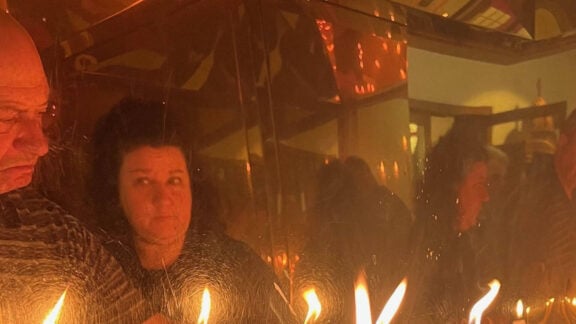A remarkable community, cultural and intellectual exchange unfolded in Canberra between the Greek and Indian communities on May 27, as the Hellenic Club was the venued for a lecture exploring the Indian perspective on truth and beauty in Homer’s epics.
Renowned Sanskrit scholar and Hellenist, Vidwan Sri Arjun Bharadwaj’s lecture , ‘Indian Perspective of Truth and Beauty in Homer’s Epics’, was based on his book Indian Perspective of Truth and Beauty in Homer’s Epics – a comparative study of the Greek Epics Iliad and Odyssey.
The event was held at the the Hellenic Club of Canberra, and co-hosted by the Greek Orthodox Community and Church of Canberra (GOCCC), and Fair Canberra.
Modern Australian partnership based on ancient bonds
John Loukadellis—Director of The Hellenic Initiative Australia (THI Australia) and President of the Greek Orthodox Community and Church—told Neos Kosmos that Arjun Bharadwaj’s “expression of the Indian culture and mythology and the parallels that run between the Greek mythology and Indian mythology was amazing.”
“It opened my eyes, and I was already a ‘Greeindian’ as he called me,” said Loukadellis.
A. Bharadwaj—studied Classical Greek at the University of Zurich—his reflections resonated with attendees, as he drew thought-provoking parallels between the Homeric tradition and ancient Indian philosophies, particularly through shared ideals of truth, beauty, dharma, and fate.
“He was absolutely brilliant -he drew parallels between our communities, our strengths, culture and heritage, and stories. He spoke for over two hours, and I tell you, 40 old people in the room were enthralled—as I was.”

Canberra’s Greeks reach out
Loukadellis said he organised the event because there are “26,000 Indians in the community” in Canberra.
“I thought we need to do things with the Indian community, get their support—they’re a great people and proud like us.”
Loukadellis is committed to partnering with the Indian community. He “reached out” to Dr. Shanti Swarup Reddy, President of the Federation of Indian Associations of Canberra (FINACT).
“Shanti and I are good friends, so we just said, ‘Let’s organise something,'” the THI director said.
He then called in Fair Canberra Inc., a body committed to bringing multicultural communities together.
“I called Nic Manikis, the chairman, and said we need to bridge communities—and he jumped at it.”
“Fair Canberra is a group of different multicultural leaders. We sit down together and discuss ways of helping different charitable arms of Canberra’s communities—whether it is a machine for a hospital or better access and fair policies for all multicultural communities.”
The event sparked a dynamic discussion among the diverse audience, many of whom were visibly moved by the shared philosophical depth of the Greek and Indian civilisations.

India and Hellenism – syncretic civilisations in conversation
For Bharadwaj, Homer’s Iliad and Odyssey are moral and philosophical inquiries not unlike those found in Indian texts such as the Mahabharata and the Upanishads.
Loukadellis said the parallels between Homer’s Iliad and the Indian Mahabharata were “astounding.”
He said the parallels between Paris’ abduction of Helen and the story of Draupadi and her abduction—and how “one man’s act can create such catastrophe”—resonates across the two civilisations.
Indian philosophy, literature, and science once travelled westward through Persia into the pre-Hellenic regions of the ancient Mediterranean.
Centuries later, Alexander the Great’s campaign eastward would culminate in the confrontation with the armies of the Indus Valley—an encounter that not only marked a military impasse but gave rise to a syncretic Indo-Hellenic civilisation. This cultural fusion lasted for more than a millennium and left profound artistic and philosophical legacies.
Some of the earliest visual depictions of the Buddha were sculpted in the Indo-Hellenic style. Intriguingly, it is believed that some of the first Buddhist monks to carry the faith to China were themselves of Greek origin.
Dialogue between civilisations
By reframing Homer’s concepts of good (καλό) and truth (αλήθεια) through Indian notions of satya and rasa, the lecture highlighted how two great civilisations, though distinct, share an enduring search for meaning and transcendence.
“Truth in both traditions is not just factual,” Bharadwaj said in Indian media.
“It’s existential. It is lived, pursued, wrestled with. And beauty is not merely aesthetic—it is transformative.”
For many attendees, the evening was not just an academic exercise but a profound reminder of the universal human questions that continue to bind diverse peoples across millennia.
Loukadellis told Neos Kosmos that as “ancient connected civilisations—and as diasporas—Greeks and Indians share much”, and together they are “conduits for events and advocacy for the ACT’s diverse communities”.
“Events like this show us how interconnected we are,” he told Neos Kosmos.
“I want us, as Greeks to do much more with all the other communities, such as the Chinese,” he added.
In a time when cultural polarisation dominates headlines, the Canberra event offered a narrative—of shared heritage, philosophical kinship, and the timeless beauty of dialogue in the nation’s capital.









